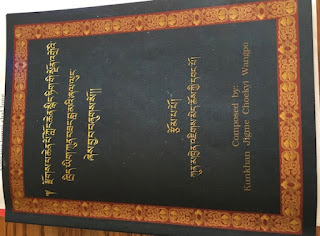Studying Tibetan Language
For someone keen to learn Tibetan, it's good to have an initial understanding what one wants to learn. Tibetan language, བོད་སྐད་ is not a unified form of language. To start with you have spoken Tibetan and classical Tibetan used in Tibetan Buddhist scriptures. Even classical written Tibetan has an old form (7th to 11th century) and a standardized classical form (12th to 19th century). The modern literary Tibetan is very recent (20th century) and spoken Tibetan was not really used in written form, such as newspapers and web sites, until now.
Dharma Tibetan, ཆོས་སྐད་, is the term used for the written language for religious and philosophical texts. To some degree teachings given by Tibetan Buddhist teachers also use this form for scriptural quotations, even if spoken standard Tibetan is usually the main form. Other names for this more formal speech is ཡིག་སྐད་ or མཁས་པའི་ཁ་སྐད་ . There are also levels of politeness associated with to who you talk (your father, teacher versus your kids), the higher form is called ཞེ་ས་. You need to learn many words that have both a common usage name and a higher polite name.
Then different regions in Tibet have dialects and the spoken form in Lhasa is referred to as ལྷ་སའི་སྐད་. The diaspora outside Tibet has also taken loan words from Hindu and English. A funny expression of mixing Tibetan with other languages is called ར་མ་ལུགས་སྐད་ , sheep-not-goat language!
All together, just learning dharma terms in Tibetan is already a nice and fun way to explore Tibetan religion and culture.
More Information: Manual Of Standard Tibetan by Nicolas Tournadre & Sangda Dorje
Dharma Tibetan, ཆོས་སྐད་, is the term used for the written language for religious and philosophical texts. To some degree teachings given by Tibetan Buddhist teachers also use this form for scriptural quotations, even if spoken standard Tibetan is usually the main form. Other names for this more formal speech is ཡིག་སྐད་ or མཁས་པའི་ཁ་སྐད་ . There are also levels of politeness associated with to who you talk (your father, teacher versus your kids), the higher form is called ཞེ་ས་. You need to learn many words that have both a common usage name and a higher polite name.
Then different regions in Tibet have dialects and the spoken form in Lhasa is referred to as ལྷ་སའི་སྐད་. The diaspora outside Tibet has also taken loan words from Hindu and English. A funny expression of mixing Tibetan with other languages is called ར་མ་ལུགས་སྐད་ , sheep-not-goat language!
All together, just learning dharma terms in Tibetan is already a nice and fun way to explore Tibetan religion and culture.
More Information: Manual Of Standard Tibetan by Nicolas Tournadre & Sangda Dorje

